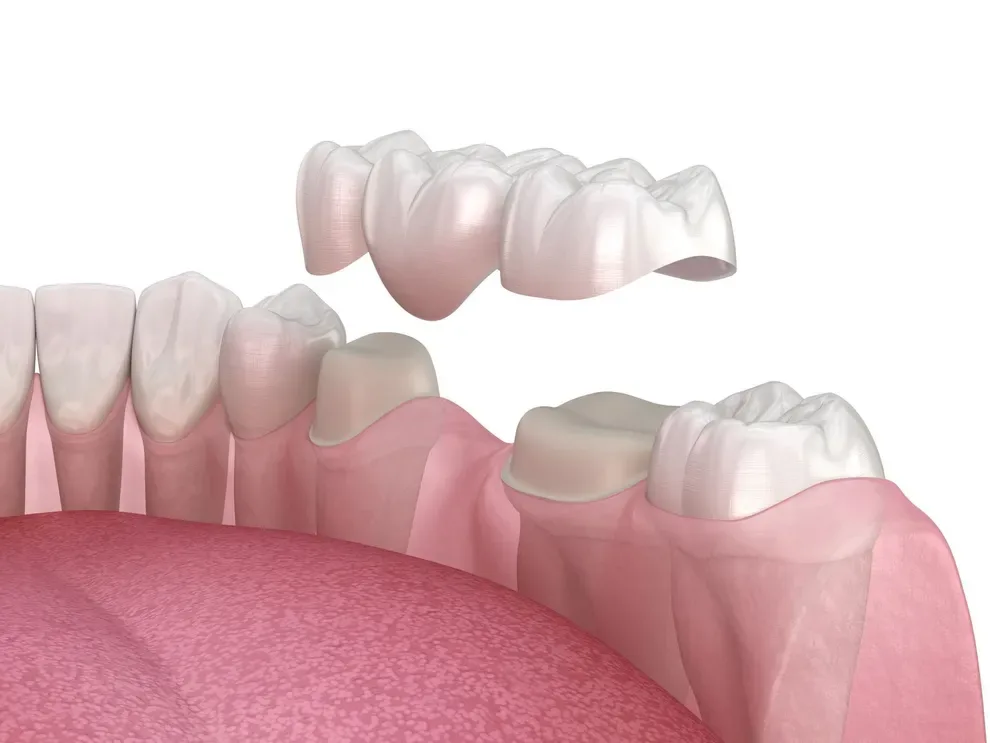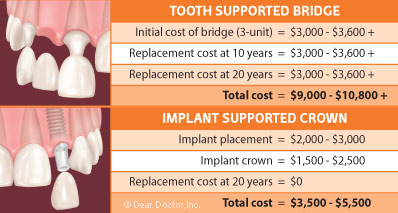The cost of a dental bridge with insurance varies depending on your plan and coverage. Dental bridge cost with insurance can range from $500 to $1500.
For many people, dental insurance can help offset the cost of a dental bridge, making it more affordable. Dental bridges are a common and effective solution for replacing missing teeth. They can restore your smile and improve chewing and speaking abilities.
If you’re considering a dental bridge, understanding the cost with insurance is an important factor in your decision-making process. We’ll explore the typical cost of dental bridges with insurance and factors that can affect the overall expense.
Introduction To Dental Bridge Costs
Dental bridge costs can vary depending on whether or not you have insurance coverage. With insurance, you may be able to receive partial or full coverage for the procedure, which can help alleviate some of the costs associated with getting a dental bridge.
When it comes to dental bridges, one important factor to consider is the cost. Understanding the various aspects that influence dental bridge costs can help you make an informed decision about your dental treatment. In this section, we will explore the basics of dental bridges and the factors that can impact their costs.
The Basics Of Dental Bridges
Dental bridges are a common restorative dental treatment used to replace missing teeth. They are custom-made prosthetic devices that bridge the gap created by one or more missing teeth. A dental bridge consists of two or more crowns on either side of the gap, known as abutment teeth, and a false tooth or teeth in between, known as pontics.
The cost of a dental bridge can vary depending on several factors, including the number of missing teeth, the materials used, and the complexity of the case. It is essential to consult with a dentist to determine the best type of dental bridge for your specific needs and budget.
Factors Influencing Costs
Several factors can influence the overall cost of a dental bridge. These factors include:
- The number of missing teeth: The more teeth you need to replace, the higher the cost of the dental bridge.
- The materials used: Dental bridges can be made from various materials, including porcelain, metal alloys, or a combination of both. Each material has its own cost implications.
- The complexity of the case: Some cases may require additional procedures, such as bone grafting or periodontal treatment, which can affect the overall cost.
- The location of the dental practice: Dental bridge costs can vary depending on the geographic location of the dental practice.
- Dental insurance coverage: If you have dental insurance, it may cover a portion of the dental bridge cost. However, coverage can vary depending on your specific insurance plan.
It’s important to note that dental bridge costs can vary significantly from one patient to another. To get an accurate estimate of the cost, it’s best to schedule a consultation with a dentist who can evaluate your specific situation and provide a personalized treatment plan.

Credit: vossdental.com
Insurance Coverage For Dental Bridges
Insurance coverage for dental bridges can significantly reduce out-of-pocket costs, making this tooth replacement option more affordable for many. With insurance, patients can expect to pay less for dental bridge procedures, promoting better oral health without breaking the bank.
Dental bridges are a common solution to replace missing teeth. While the procedure is necessary for maintaining oral health, the cost can be a concern for many patients. Fortunately, dental insurance can help cover the cost of dental bridges. In this article, we will discuss the types of dental insurance plans and what insurance typically covers when it comes to dental bridges.Types Of Dental Insurance Plans
There are two main types of dental insurance plans: PPO and HMO. A PPO plan allows you to visit any dentist you choose, while an HMO plan requires you to select a dentist within a network. PPO plans tend to have higher premiums but offer more flexibility, while HMO plans have lower premiums but less flexibility.What Insurance Typically Covers
Dental insurance typically covers a portion of the cost of dental bridges. The exact amount of coverage depends on your specific plan and the type of bridge you need. For example, insurance may cover up to 50% of the cost of a traditional bridge, but only 10% of the cost of a more expensive implant-supported bridge. It’s important to note that insurance may also have a waiting period before covering certain procedures, including dental bridges. Be sure to check with your insurance provider to understand your coverage and any waiting periods that may apply. In conclusion, dental insurance can help offset the cost of dental bridges. Understanding your specific plan and coverage can help you make an informed decision about your oral health care.Calculating Your Costs With Insurance
How To Read Your Insurance Plan
Understanding the specifics of your dental insurance plan is vital to calculate your out-of-pocket expenses for a dental bridge. Locate the section that outlines coverage for major procedures, such as bridges, and note any deductibles, copayments, and annual maximums.
Estimating Out-of-pocket Expenses
Estimating your out-of-pocket expenses involves reviewing your insurance plan, obtaining a treatment plan from your dentist, and confirming coverage details with your insurer. By considering your deductible, copayment, and coverage percentage, you can calculate the portion of the cost you’ll be responsible for.
Types Of Dental Bridges And Their Costs
Exploring the various types of dental bridges can help you make an informed decision about restoring your smile. Let’s delve into the different types and associated costs.
Traditional Bridges
Traditional bridges are the most common type, typically costing between $500 to $1,500 per tooth.
Cantilever Bridges
Cantilever bridges are used when there are adjacent teeth on only one side of the missing tooth. These bridges can cost around $1,000 to $2,500 per tooth.
Maryland Bridges
Maryland bridges are a conservative option, with a price range of $1,500 to $2,500 per tooth.
Implant-supported Bridges
Implant-supported bridges are the most durable and can cost between $3,000 to $5,000 per tooth, but they provide a long-lasting solution.
Additional Costs To Consider
When planning for a dental bridge procedure with insurance coverage, it’s crucial to account for additional costs that may arise. These costs go beyond the basic treatment expenses and can impact your overall budget.
Preparatory Procedures
- Initial dental exam and X-rays.
- Tooth extraction, if necessary.
Follow-up Care
- Post-procedure check-ups.
- Potential adjustments to the bridge.
Replacement And Maintenance
Regular maintenance and potential replacements are essential for the longevity of your dental bridge.

Credit: www.byte.com
How To Reduce Your Dental Bridge Costs
If you need to get a dental bridge, you may be wondering how to reduce your dental bridge costs. While dental bridges can be a significant investment, there are ways to save money on this important dental procedure. In this post, we’ll explore some strategies for reducing your dental bridge costs, including dental discount plans, payment plans and financing, and choosing the right dentist.
Dental Discount Plans
If you’re looking for a way to reduce your dental bridge costs, a dental discount plan may be a good option. These plans offer discounted rates on dental procedures, including dental bridges, to members who pay a monthly or annual fee. With a dental discount plan, you can save up to 50% or more on your dental bridge costs. Some popular dental discount plans include DentalPlans.com and Careington.
Payment Plans And Financing
Another way to reduce your dental bridge costs is to take advantage of payment plans and financing options. Many dentists offer payment plans that allow you to pay for your dental bridge over time, rather than all at once. Additionally, some dentists offer financing options that allow you to finance your dental bridge at a low interest rate. Be sure to ask your dentist about these options if you’re interested in reducing your dental bridge costs.
Choosing The Right Dentist
Finally, choosing the right dentist can also help you reduce your dental bridge costs. Look for a dentist who offers competitive pricing and is willing to work with you to create a payment plan that fits your budget. Additionally, consider a dentist who offers a warranty on their work, as this can save you money if something goes wrong with your dental bridge down the line.
| Strategy | Description |
|---|---|
| Dental Discount Plans | Offer discounted rates on dental procedures to members who pay a monthly or annual fee. |
| Payment Plans and Financing | Allow you to pay for your dental bridge over time, rather than all at once. |
| Choosing the Right Dentist | Look for a dentist who offers competitive pricing and is willing to work with you to create a payment plan that fits your budget. |
- A dental discount plan can save you up to 50% or more on your dental bridge costs.
- Payment plans and financing options can help you pay for your dental bridge over time, rather than all at once.
- Choosing the right dentist can help you find competitive pricing and a payment plan that fits your budget.
- Consider signing up for a dental discount plan to save on dental bridge costs.
- Ask your dentist about payment plans and financing options.
- Choose a dentist who offers competitive pricing and a warranty on their work.
Insurance Claims For Dental Bridges
When it comes to getting dental bridges, understanding how insurance coverage works can help you plan your finances effectively. Filing an insurance claim for dental bridges can be a straightforward process if you know what to expect. In this section, we will guide you through the steps of filing a claim and also discuss how to deal with claim denials.
Filing A Claim
Filing a claim for dental bridge insurance coverage is a relatively simple process that involves a few key steps:
- Contact your insurance provider: Reach out to your insurance company to inquire about your dental bridge coverage and the specific details of your policy.
- Obtain necessary documentation: Ask your dentist to provide you with all the required documents, such as cost estimates, treatment plans, and any other supporting materials needed for the claim.
- Complete the claim form: Fill out the insurance claim form accurately, providing all the necessary information. Make sure to include the details of your dental bridge procedure, including the type of bridge and the number of teeth being replaced.
- Submit the claim: Send the completed claim form along with the supporting documentation to your insurance provider either online or through mail, following their preferred method of submission.
- Follow up: Keep track of your claim and follow up with your insurance company to ensure that it is being processed in a timely manner.
Dealing With Claim Denials
If your dental bridge insurance claim is denied, don’t panic. There are steps you can take to address the situation:
- Review the denial letter: Carefully read the denial letter provided by your insurance company. It should outline the specific reasons for the denial.
- Contact your dentist: Reach out to your dentist to discuss the denial and seek their guidance. They may be able to provide additional documentation or help you understand the insurance company’s reasoning.
- File an appeal: If you believe that the denial was incorrect or unjustified, you have the right to appeal the decision. Follow the instructions provided by your insurance company to initiate the appeals process.
- Provide additional information: Gather any additional information or documentation that may support your claim and submit it as part of the appeals process. This may include x-rays, photographs, or letters from your dentist.
- Follow up: Stay in communication with your insurance company throughout the appeals process to ensure that your case is being reviewed and considered.
Dealing with insurance claim denials can be frustrating, but by staying proactive and persistent, you can increase your chances of getting the coverage you deserve for your dental bridge procedure.
Real-life Examples And Testimonials
Real-life examples and testimonials can provide valuable insight into the cost of dental bridges with insurance. Patients can share their experiences with insurance coverage, pricing, and overall satisfaction with the procedure. Reading these firsthand accounts can help individuals make informed decisions when considering dental bridge treatment.
When it comes to dental bridge cost with insurance, hearing real-life examples and testimonials can provide valuable insights and reassurance. Success stories from individuals who have undergone dental bridge procedures can help alleviate concerns and shed light on the benefits of this dental solution. Navigating challenges throughout the process is an important aspect, and understanding how others have overcome obstacles can provide encouragement and guidance.
Success Stories
Real-life success stories serve as inspiring testaments to the effectiveness and positive outcomes of dental bridge procedures. These testimonials highlight the life-changing impact of restoring missing teeth with the help of dental bridges. Let’s take a look at a couple of remarkable success stories:
- John’s Journey to a Confident Smile: John, a 45-year-old professional, had been struggling with a missing tooth for several years. It affected his self-esteem and made him hesitant to smile. After consulting with his dentist, he opted for a dental bridge. The procedure was painless, and the results were astonishing. John regained his confidence and now proudly displays his restored smile. He can eat his favorite foods without any discomfort and enjoys improved oral health.
- Sarah’s Renewed Dental Functionality: Sarah, a 60-year-old retiree, faced challenges due to multiple missing teeth. Eating and speaking became difficult, and she experienced discomfort and pain. Seeking a solution, Sarah chose dental bridges to restore her dental functionality. The transformation was incredible. Sarah can now chew her food properly, speak clearly, and her overall quality of life has improved significantly.
Navigating Challenges
While success stories are inspiring, it’s important to acknowledge the challenges that may arise during the dental bridge process. Navigating these challenges with the support of dental professionals can ensure a smoother experience. Here are some common challenges individuals face and how they can be overcome:
- Financial Considerations: The cost of dental bridges may vary depending on factors such as location and insurance coverage. However, many dental insurance plans offer coverage for dental bridges, making them more affordable. It is important to thoroughly understand your insurance policy and discuss financing options with your dentist to find the best solution for your budget.
- Temporary Discomfort: After the dental bridge procedure, some individuals may experience temporary discomfort such as sensitivity or soreness. This is normal and can be managed with over-the-counter pain relievers or prescribed medication, if necessary. It is essential to follow the post-procedure care instructions provided by your dentist for a comfortable recovery.
- Adjusting to the Bridge: Adapting to the sensation of a dental bridge may take some time. Initially, speech and eating patterns may feel slightly different. However, with practice and patience, individuals quickly adjust to the bridge, and it becomes a natural part of their oral function.
Real-life examples and testimonials, along with insights into navigating challenges, provide a comprehensive understanding of dental bridge cost with insurance. By learning from the experiences of others, individuals can make informed decisions and embark on their own journey towards a confident and functional smile.

Credit: www.mooresvilledental.net
Frequently Asked Questions
How Much Does A Dental Bridge Cost With Insurance?
The cost of a dental bridge with insurance can vary based on the type of bridge and your coverage. Typically, insurance may cover a portion of the cost, reducing your out-of-pocket expenses. It’s best to check with your insurance provider for specific details.
What Factors Can Affect The Cost Of A Dental Bridge?
Several factors can influence the cost of a dental bridge, including the type of bridge, materials used, additional treatments required, and the location of the dental practice. Additionally, insurance coverage and any out-of-pocket expenses can also impact the overall cost.
Is A Dental Bridge A Cost-effective Solution For Missing Teeth?
Yes, a dental bridge can be a cost-effective solution for replacing missing teeth. It provides a stable and natural-looking restoration that can improve oral function and aesthetics. Additionally, with insurance coverage, the overall cost of getting a dental bridge can be more manageable for patients.
How Can Insurance Help In Reducing The Cost Of A Dental Bridge?
Dental insurance can help reduce the cost of a dental bridge by covering a portion of the expenses. This can make the treatment more affordable for patients. It’s important to review your insurance policy to understand the coverage details and any potential out-of-pocket costs associated with the procedure.
Conclusion
Understanding dental bridge costs with insurance is essential for financial planning. Explore your coverage options to make informed decisions about your oral health. Consider consulting with your dentist and insurance provider for personalized cost estimates. Stay proactive about your dental care!
